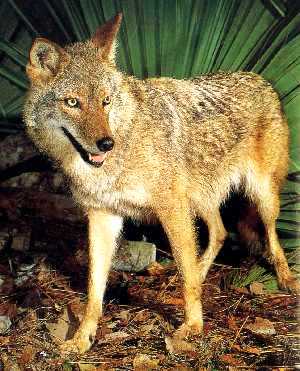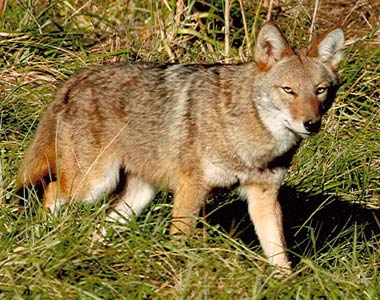Discover Florida Nature
It's time to explore the natural Florida


|
|
|
|
|
 The
coyote (Canis latrans), once strictly a western species, now
occurs throughout the eastern United States. Coyotes began expanding
their range into the Southeast in the 1960s, reaching northwestern
Florida in the 1970s. In a 1981 survey, coyotes were reported in 18 of
Florida's 67 counties. A similar survey in 1988 reported coyotes in 48
counties. In 2009 Coyotes have been seen in every Florida county except
Monroe, and it's only a matter of time before they're howling in Key
West at happy hour! The demise of the red wolf
and the Florida panther, both natural
coyote predators has been associated with the rise of the coyote. The
coyote (Canis latrans), once strictly a western species, now
occurs throughout the eastern United States. Coyotes began expanding
their range into the Southeast in the 1960s, reaching northwestern
Florida in the 1970s. In a 1981 survey, coyotes were reported in 18 of
Florida's 67 counties. A similar survey in 1988 reported coyotes in 48
counties. In 2009 Coyotes have been seen in every Florida county except
Monroe, and it's only a matter of time before they're howling in Key
West at happy hour! The demise of the red wolf
and the Florida panther, both natural
coyote predators has been associated with the rise of the coyote. The coyote is a member of the dog family, similar in appearance to a medium size shepherd. They weigh between 20 and 30 pounds, have pointed ears, a narrow muzzle, and bushy tail. Males tend to be larger than females. Their coat varies from gray to rusty brown, often with a patch of white chest hair. When running, coyotes usually hold their tails at "half mast." Coyote tracks are narrower and more elongated than dog tracks. The scientific name of the coyote, Canis latrans, literally means barking dog. Coyotes exhibit a variety of vocalizations. They can bark like dogs, though the sounds most often heard are shrill yips and howls. Howling is often a group effort, perhaps beginning as a simple howl, but quickly increasing in intensity to a series of group howls and high-pitched barks. Howling may function as a greeting between coyotes or as a territorial claim between groups. Coyotes usually hunt alone, sometimes as a pair, but rarely, as a pack. The most important foods are rats and mice, rabbits, wild fruits, insects, birds and virtually any type of carrion. Coyotes kill an animal because it is a food source and are very skilled hunters. They may attack fleeing animals from the rear, biting their legs or tail to slow them down. They most often kill by biting the throat, causing death by suffocation. Coyotes usually take their prey with them to a safe place to eat. They may carry their prey up to one mile before consuming it. They do not leave much behind and tend to eat whatever can fit in their mouth. In some cases, they have even eaten the leather collar of a pet. Coyotes may provide an ecological benefit by controlling populations of small predators, such as raccoons and feral cats, that raid nests and eat eggs of migratory birds.  Coyotes
are elusive. They are more active at dawn and dusk, but can be seen
almost anytime during the day or night. Home-range size depends on
geographic and seasonal factors. Coyotes can have a home range of 1,500
to 12,000 acres. This is just one more animal that relies on large
amounts of connecting native lands to survive Coyotes may travel
individually or in groups of two or three. Food is an important factor
in coyote population densities. In Texas, coyote densities in the fall
varied from 0.6 to 0.9 individuals per square mile. Being social
animals, coyotes often vocalize excitedly, with yips and barks, when
encountering others. Vocalizations from two or three individuals often
give the impression that many more animals are involved. Coyotes
are elusive. They are more active at dawn and dusk, but can be seen
almost anytime during the day or night. Home-range size depends on
geographic and seasonal factors. Coyotes can have a home range of 1,500
to 12,000 acres. This is just one more animal that relies on large
amounts of connecting native lands to survive Coyotes may travel
individually or in groups of two or three. Food is an important factor
in coyote population densities. In Texas, coyote densities in the fall
varied from 0.6 to 0.9 individuals per square mile. Being social
animals, coyotes often vocalize excitedly, with yips and barks, when
encountering others. Vocalizations from two or three individuals often
give the impression that many more animals are involved.Coyotes have one breeding cycle per year. The male, unlike the domestic dog, has active sperm only in late winter when females are in heat. Coyotes can first breed when they are 10 months old. The proportion of the yearling females that breed varies as a function of food supply: in good years, a higher proportion breed than in years when food is scarce. A mating pair might breed from year to year but not necessarily for life. Coyotes can breed with domestic dogs and produce fertile offspring. Hybridization, or the mating of two individuals of different species, occurs infrequently in the wild. Coyotes breed in late winter. Following a 63-day gestation period an average of 6 coyote pups are born. Both parents, and occasionally non-breeding offspring from previous years, help rear the young. Den sites are typically found in hollow logs, abandoned burrows, dense vegetation or brush-covered slopes. Dens are abandoned when pups are eight to 10 weeks of age. Juveniles disperse or move into unoccupied areas and establish new territories typically when they are nine to ten months old. The average life span of coyotes is five to six years in the wild, with mortality being greatest during the first year. |
|
|
Advertise | Privacy Statement | Contact | Alaska Nature | Michael Arnold Art| Dog Encyclopedia | Dog Encyclopedia| |
|